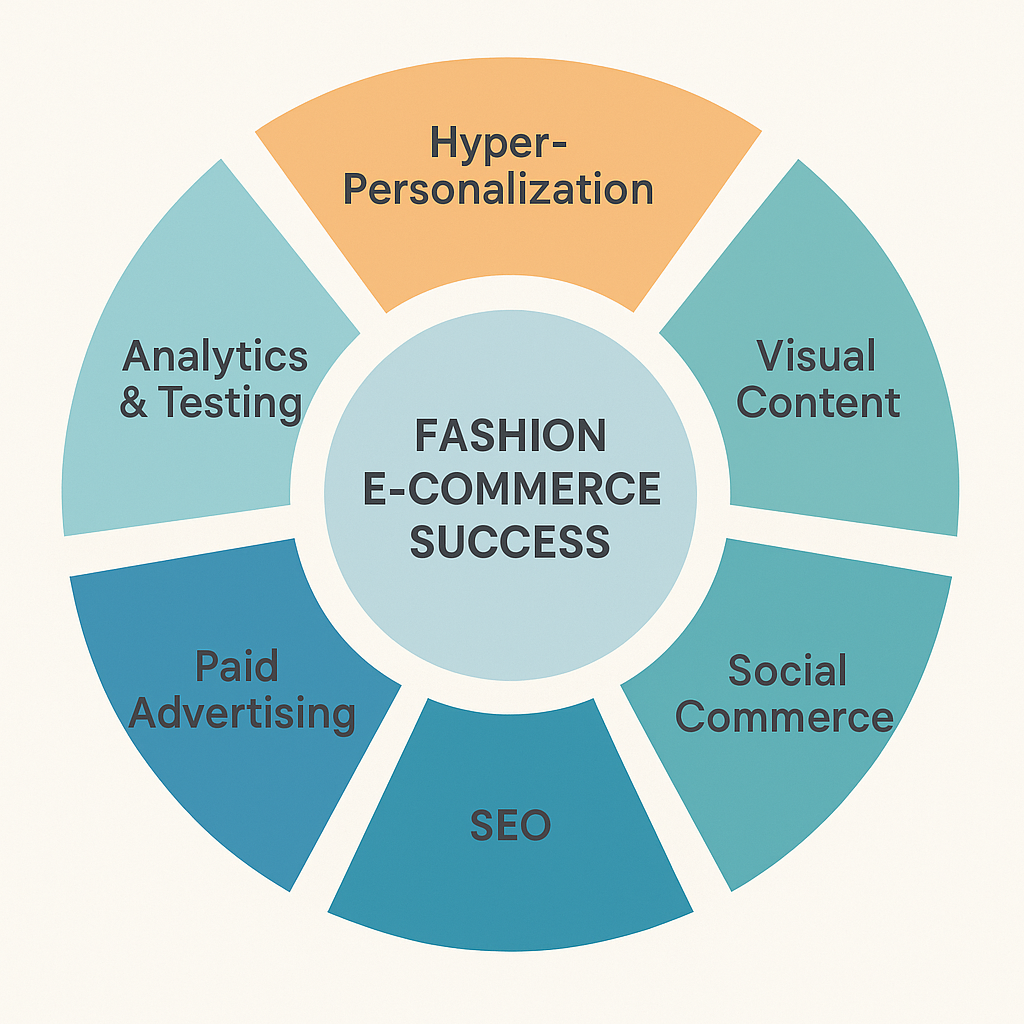Top Digital Marketing Strategies for Fashion E-Commerce in 2025
I. Stepping Up Your Fashion E-Commerce Game in 2025
The digital landscape is changing faster than ever, especially in the world of fashion. In 2025, standing out in fashion e-commerce isn’t just about having trendy clothes—it’s about having smart, future-focused digital marketing strategies that meet your customers exactly where they are.
As someone managing an e-commerce clothing store that offers styles for men, women, and kids, I’ve seen firsthand how digital marketing can either drive your business forward. In this article, I’ll walk you through the “top digital marketing strategies for fashion e-commerce in 2025”. This is a beginner-friendly guide to help you future-proof your brand and drive results in the competitive online fashion space.
II. The Foundation: Understanding Your Audience and Brand in 2025
A. Deep Diving into Demographics and Psychographics
In 2025, it’s no longer enough to know your customer’s age or gender. You need to understand their interests, values, lifestyle, and shopping behavior. Fashion is personal, and your digital marketing should reflect that. I use tools like Google Analytics and social media insights to segment my audience into buyer personas—this helps me craft campaigns that feel personal and relevant.
B. Crafting Your Unique Brand Story
Your brand is more than just your logo or product range. It’s the experience and emotion you deliver. Ask yourself, what does your clothing represent? Is it about sustainability, bold self-expression, or budget-friendly style? When you define this, your messaging becomes consistent and your brand stands out in a crowded marketplace.
C. Leveraging Data and Analytics
I rely heavily on data to make informed decisions. From tracking which collections perform best to analyzing customer journeys, using data and analytics ensures that my marketing isn’t based on guesswork. In 2025, data-driven marketing is the standard, not the exception.
III. Top Digital Marketing Strategies for Fashion E-Commerce in 2025

A. Hyper-Personalization at Scale
- AI-Powered Product Recommendations
Using AI tools like personalized product recommendations can transform your customer’s browsing experience. Whether someone is looking for kids’ wear or the latest men’s streetwear, dynamic product suggestions based on browsing history increase the likelihood of conversion.
- Tailored Email Marketing Journeys
I no longer send the same email to every subscriber. With automation tools, I can create email flows tailored to different shopper behaviors—such as cart abandonment, first-time visitors, or VIP customers. This kind of personalization builds trust and drives repeat purchases.
- Dynamic Website Experiences
In 2025, websites are adapting in real time. Based on visitor behavior, location, or even weather, your website can change its homepage banners, product highlights, or promotional offers. This keeps the shopping experience fresh and relevant.
B. The Power of Visuals: Immersive Content That Sells
- High-Quality Photography and Videography
First impressions matter. That’s why I invest in high-quality visuals. Whether it’s clean product photos or short videos showing outfits in motion, visual content boosts credibility and gives customers the confidence to buy.
- Interactive Look books and Virtual Try-Ons
Virtual try-on tools and interactive look books are becoming standard in fashion e-commerce. These immersive experiences let customers visualize how clothing will look on them, reducing return rates and increasing satisfaction.
- User-Generated Content and Influencer Collaborations
UGC builds trust. I encourage customers to post photos wearing our products, and I repurpose this content on social media and product pages. Partnering with micro-influencers also brings authenticity and introduces the brand to new audiences.
C. Social Commerce and Community Building
1. Dominating Key Platforms
Controlling Important Platforms In 2025, Instagram remains the most popular platform.
. These platforms are not just for brand awareness—they’re direct sales channels. Short-form video, reels, and behind-the-scenes content build emotional connection with your audience.
2. Shoppable Posts and Live Shopping Events
Thanks to integrated shopping features, my followers can buy directly from posts and videos. Hosting live shopping events on Instagram also creates urgency and boosts real-time engagement.
3. Building Engaged Communities
A loyal community will drive long-term success. I regularly interact with followers, ask questions, share customer stories, and create a two-way relationship that makes people feel like part of something bigger than just a store.
D. SEO for Fashion: Getting Discovered in a Crowded Market
1. Keyword Research for Fashion Trends
Search trends change with seasons and fads. I keep an eye on what’s trending using Google Trends and fashion keyword tools. Optimizing category pages for “sustainable kids fashion 2025” or “men’s athleisure wear trends” can significantly boost traffic.
2. On-Page Optimization
From product titles to meta descriptions, I ensure every element of my product pages is optimized. This includes clear headings, fast-loading images, and mobile responsiveness—key factors that influence search rankings.
3. Local SEO
If you have a physical presence or cater to a specific region, don’t neglect local SEO. I make sure my Google Business Profile is updated, and I use location-based keywords like “affordable kids wear in Gurdaspur” to attract local traffic.
E. Paid Advertising Reimagined: Strategic Investing for Optimal Effect
1. Targeted Social Media Ads
Customized Social Media Promotions Ad platforms are smarter than ever in 2025. I run targeted campaigns based on customer behavior, interests, and even life events. Whether I’m promoting a summer collection or a clearance sale, the right targeting makes every dollar count.
2. Google Shopping and Performance Max Campaigns
These campaigns use AI to place ads across Google’s entire network. For my store, this means my products show up in search, YouTube, Gmail, and more—maximizing visibility and conversions with less manual effort.
3. Retargeting Strategies
Strategies for Retargeting On their initial visit, most customers don’t make a purchase. That’s why retargeting is essential. I use Facebook Pixel and Google Ads to bring back interested shoppers with reminders, offers, and fresh content.
IV. Measuring Success: How to Know You’re on the Right Track
A. Key Performance Indicators (KPIs)
I regularly track KPIs like conversion rate, customer acquisition cost (CAC), average order value (AOV), and return on ad spend (ROAS). These numbers help me measure what’s working—and what’s not.
B. Utilizing Analytics Tools
Google Analytics 4 (GA4) gives me deep insights into customer journeys, while tools like Hotjar help visualize where users are dropping off. These insights help refine everything from homepage layout to checkout flow.
C. A/B Testing and Optimization
Testing different headlines, images, and CTAs is part of my weekly routine. A/B testing helps ensure I’m not relying on assumptions but making data-backed decisions to continuously improve performance.
V. Looking Ahead: Future Trends and Staying Agile
A. The Rise of Web3 and NFTs in Fashion
While still emerging, Web3 technologies like NFTs and blockchain will impact digital fashion ownership and authentication. I’m exploring how to use these for limited-edition virtual wearables or loyalty programs.
B. Sustainability and Ethical Marketing
Customers in 2025 are more conscious than ever. I focus on highlighting our sustainable materials, ethical sourcing, and transparent supply chains—not just as a trend but as a core value.
C. The Importance of Adaptability
The only constant in digital marketing is change. Whether it’s new platforms, algorithm updates, or consumer behavior shifts, staying flexible and open to innovation is what keeps my business growing.
VI. Conclusion: Your Journey to Fashion E-Commerce Success in 2025
Digital marketing in fashion e-commerce is no longer optional—it’s essential. From hyper-personalization and visual content to SEO and smart ad spend, these strategies help you not just survive but thrive in 2025.
If you’re just starting out, don’t feel overwhelmed. Pick one strategy, master it, and build from there. I started small too—and by staying focused, consistent, and data-driven, I’ve been able to grow a brand that stands out.
The future of fashion e-commerce is bright, and with the right digital marketing strategies, your brand can lead the way.

